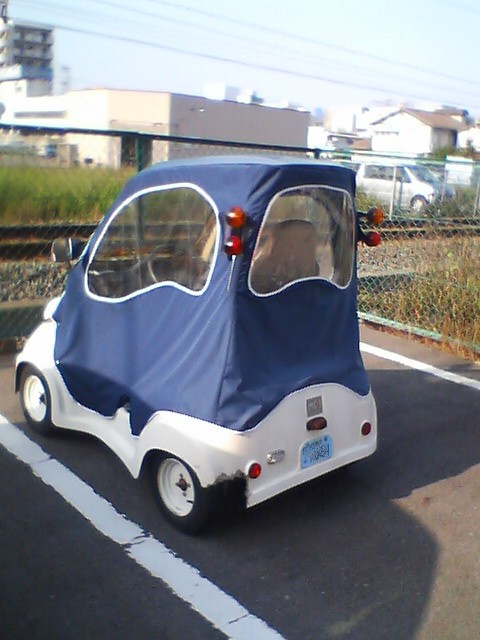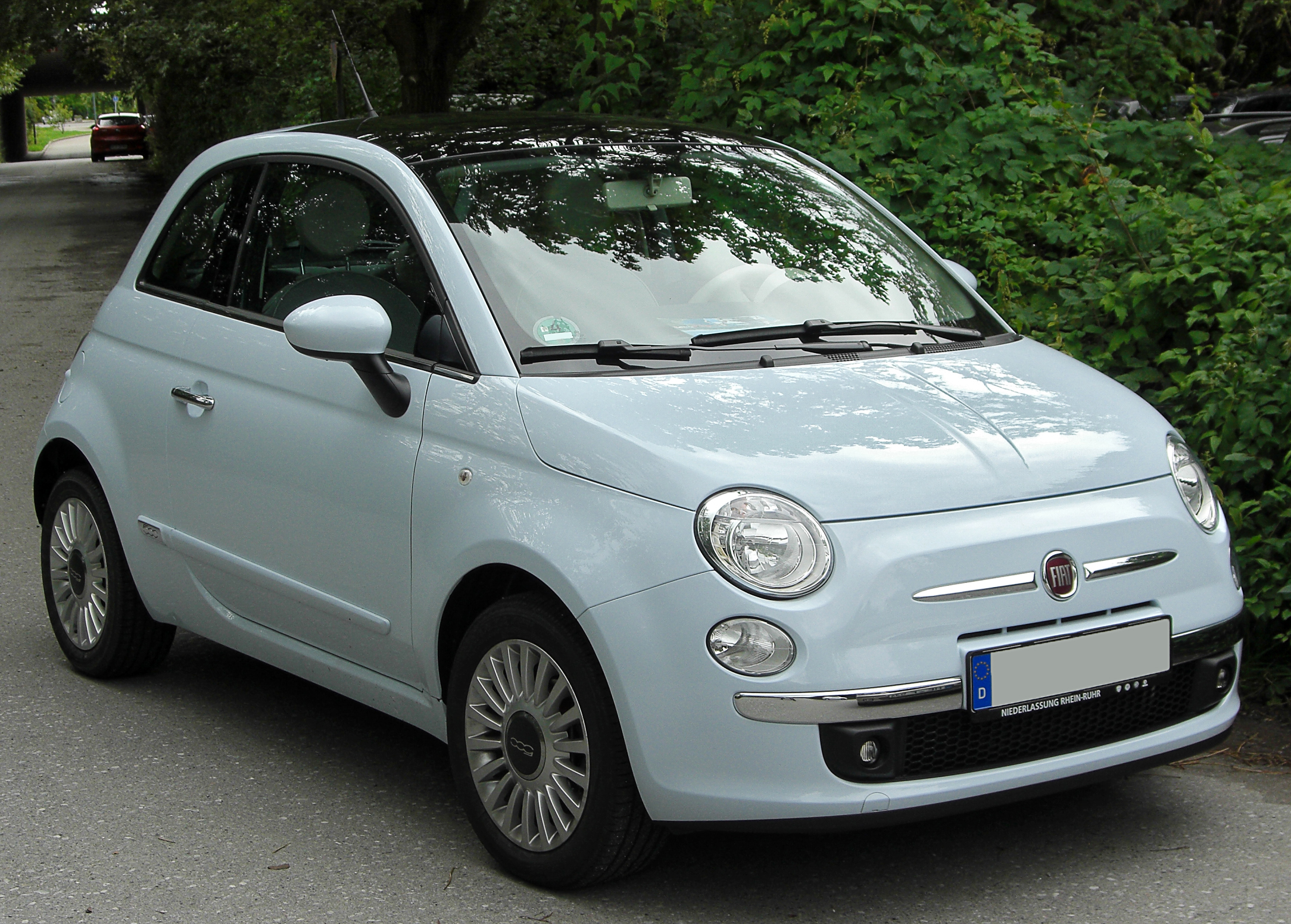|
Mitsuoka MC-1
The Mitsuoka MC-1 is a microcar produced by the Japanese company Mitsuoka. It has a top speed of and a engine. It lacks many items a normal car would have, (i.e. radio, airbags and GPS). When the MC-1 first went on sale, it had a base price of 385,000 yen. By 2005, the price had become 488,250 yen. For the 2005 model year, the engine was shrunk by 1 cc to a 49 cc engine. Variants ; MC-1 T : There was also a larger T variant that is heavier than the standard MC-1. There is a delivery box mount and a luggage bed. The mechanicals were the same as the MC-1. ; MC-1 EV : The EV version powered by a DC electric motor which produces 0.59 kilowatts The watt (symbol: W) is the unit of power or radiant flux in the International System of Units (SI), equal to 1 joule per second or 1 kg⋅m2⋅s−3. It is used to quantify the rate of energy transfer. The watt is named after James Wa ... (0.8 hp) of power. There are three different motors each with a different wattag ... [...More Info...] [...Related Items...] OR: [Wikipedia] [Google] [Baidu] |
Mitsuoka
is a small Japanese automobile company. It is noted for building unique cars with unconventional styling, some of which are modern while others imitate the look of American, European and particularly British retro cars of the 1950s and 1960s. Mitsuoka Motors is also the principal distributor of the retro-classic TD2000 roadster in Japan. Mitsuoka is primarily a custom design coachbuilder, customizing production cars, e.g., the Nissan March, and replacing various aspects of the bodywork. It has also produced a sports car, the Mitsuoka Orochi, Orochi. History Mitsuoka was recognised in 1996 as the 10th Japanese auto manufacturer to be registered in Japan since Honda in 1963, basing its current cars on Nissans and other Japanese car manufacturers. Mitsuoka Motor launched in the UK in 2015 under sole distribution of T W White & Sons and launched the Mitsuoka Roadster (Himiko) at the London Motor Show in 2016. Models Current lineup *1993–present Mitsuoka Viewt, Viewt *1996–p ... [...More Info...] [...Related Items...] OR: [Wikipedia] [Google] [Baidu] |
Microcar
Microcar is a term often used for the smallest size of cars, with three or four wheels and often an engine smaller than . Specific types of microcars include bubble cars, cycle cars, invacar, quadricycles and voiturettes. Microcars are often covered by separate regulations to normal cars, having relaxed requirements for registration and licensing. Predecessors Voiturette is a term used by some small cars and tricycles manufactured from 1895 to 1910. Cyclecars are a type of small, lightweight and inexpensive car manufactured mainly between 1910 and the late 1920s. Europe 1940-1970: Microcars The first cars to be described as microcars (earlier equivalents were called voiturettes or cyclecars) were built in the United Kingdom and Germany following World War II, and remained popular until the 1960s. They were originally called minicars, but later became known as microcars. France also produced large numbers of similar tiny vehicles called voiturettes, but they were rar ... [...More Info...] [...Related Items...] OR: [Wikipedia] [Google] [Baidu] |
Mid-engine Design
In automotive engineering, a mid-engine layout describes the placement of an automobile engine in front of the rear-wheel axles, but behind the front axle. History The mid-engine, rear-wheel-drive format can be considered the original layout of automobiles. A 1901 Autocar was the first gasoline-powered automobile to use a drive shaft and placed the engine under the seat. This pioneering vehicle is now in the collection of the Smithsonian Institution. Benefits Mounting the engine in the middle instead of the front of the vehicle puts more weight over the rear tires, so they have more traction and provide more assistance to the front tires in braking the vehicle, with less chance of rear-wheel lockup and less chance of a skid or spin out. If the mid-engine vehicle is also rear-drive the added weight on the rear tires can also improve acceleration on slippery surfaces, providing much of the benefit of all-wheel-drive without the added weight and expense of all-wheel-drive com ... [...More Info...] [...Related Items...] OR: [Wikipedia] [Google] [Baidu] |
Mitsuoka Motors Micro Car
is a small Japanese automobile company. It is noted for building unique cars with unconventional styling, some of which are modern while others imitate the look of American, European and particularly British retro cars of the 1950s and 1960s. Mitsuoka Motors is also the principal distributor of the retro-classic TD2000 roadster in Japan. Mitsuoka is primarily a custom design coachbuilder, customizing production cars, e.g., the Nissan March, and replacing various aspects of the bodywork. It has also produced a sports car, the Orochi. History Mitsuoka was recognised in 1996 as the 10th Japanese auto manufacturer to be registered in Japan since Honda in 1963, basing its current cars on Nissans and other Japanese car manufacturers. Mitsuoka Motor launched in the UK in 2015 under sole distribution of T W White & Sons and launched the Mitsuoka Roadster (Himiko) at the London Motor Show in 2016. Models Current lineup *1993–present Viewt *1996–present Galue *2008–presen ... [...More Info...] [...Related Items...] OR: [Wikipedia] [Google] [Baidu] |
Direct Current
Direct current (DC) is one-directional flow of electric charge. An electrochemical cell is a prime example of DC power. Direct current may flow through a conductor such as a wire, but can also flow through semiconductors, insulators, or even through a vacuum as in electron or ion beams. The electric current flows in a constant direction, distinguishing it from alternating current (AC). A term formerly used for this type of current was galvanic current. The abbreviations ''AC'' and ''DC'' are often used to mean simply ''alternating'' and ''direct'', as when they modify ''current'' or ''voltage''. Direct current may be converted from an alternating current supply by use of a rectifier, which contains electronic elements (usually) or electromechanical elements (historically) that allow current to flow only in one direction. Direct current may be converted into alternating current via an inverter. Direct current has many uses, from the charging of batteries to large power sup ... [...More Info...] [...Related Items...] OR: [Wikipedia] [Google] [Baidu] |
Kilowatts
The watt (symbol: W) is the unit of power or radiant flux in the International System of Units (SI), equal to 1 joule per second or 1 kg⋅m2⋅s−3. It is used to quantify the rate of energy transfer. The watt is named after James Watt (1736–1819), an 18th-century Scottish inventor, mechanical engineer, and chemist who improved the Newcomen engine with his own steam engine in 1776. Watt's invention was fundamental for the Industrial Revolution. Overview When an object's velocity is held constant at one metre per second against a constant opposing force of one newton, the rate at which Work (physics), work is done is one watt. : \mathrm In terms of electromagnetism, one watt is the rate at which electrical work is performed when a current of one ampere (A) flows across an electrical potential difference of one volt (V), meaning the watt is equivalent to the volt-ampere (the latter unit, however, is used for a different quantity from the real power of an electric ... [...More Info...] [...Related Items...] OR: [Wikipedia] [Google] [Baidu] |
Microcars
Microcar is a term often used for the smallest size of cars, with three or four wheels and often an engine smaller than . Specific types of microcars include bubble cars, cycle cars, invacar, quadricycles and voiturettes. Microcars are often covered by separate regulations to normal cars, having relaxed requirements for registration and licensing. Predecessors Voiturette is a term used by some small cars and tricycles manufactured from 1895 to 1910. Cyclecars are a type of small, lightweight and inexpensive car manufactured mainly between 1910 and the late 1920s. Europe 1940-1970: Microcars The first cars to be described as microcars (earlier equivalents were called voiturettes or cyclecars) were built in the United Kingdom and Germany following World War II, and remained popular until the 1960s. They were originally called minicars, but later became known as microcars. France also produced large numbers of similar tiny vehicles called voiturettes, but they were rare ... [...More Info...] [...Related Items...] OR: [Wikipedia] [Google] [Baidu] |
Cars Introduced In 1998
A car or automobile is a motor vehicle with wheels. Most definitions of ''cars'' say that they run primarily on roads, seat one to eight people, have four wheels, and mainly transport people instead of goods. The year 1886 is regarded as the birth year of the car, when German inventor Carl Benz patented his Benz Patent-Motorwagen. Cars became widely available during the 20th century. One of the first cars affordable by the masses was the 1908 Model T, an American car manufactured by the Ford Motor Company. Cars were rapidly adopted in the US, where they replaced animal-drawn carriages and carts. In Europe and other parts of the world, demand for automobiles did not increase until after World War II. The car is considered an essential part of the developed economy. Cars have controls for driving, parking, passenger comfort, and a variety of lights. Over the decades, additional features and controls have been added to vehicles, making them progressively more complex. These i ... [...More Info...] [...Related Items...] OR: [Wikipedia] [Google] [Baidu] |
Mitsuoka Vehicles
is a small Japanese automobile company. It is noted for building unique cars with unconventional styling, some of which are modern while others imitate the look of American, European and particularly British retro cars of the 1950s and 1960s. Mitsuoka Motors is also the principal distributor of the retro-classic TD2000 roadster in Japan. Mitsuoka is primarily a custom design coachbuilder, customizing production cars, e.g., the Nissan March, and replacing various aspects of the bodywork. It has also produced a sports car, the Orochi. History Mitsuoka was recognised in 1996 as the 10th Japanese auto manufacturer to be registered in Japan since Honda in 1963, basing its current cars on Nissans and other Japanese car manufacturers. Mitsuoka Motor launched in the UK in 2015 under sole distribution of T W White & Sons and launched the Mitsuoka Roadster (Himiko) at the London Motor Show in 2016. Models Current lineup *1993–present Viewt *1996–present Galue *2008–present ... [...More Info...] [...Related Items...] OR: [Wikipedia] [Google] [Baidu] |
Retro-style Automobiles
Retro style is imitative or consciously derivative of lifestyles, trends, or art forms from history, including in music, modes, fashions, or attitudes. In popular culture, the "nostalgia cycle" is typically for the two decades that begin 20–30 years ago. Definition The term ''retro'' has been in use since 1972 to describe on the one hand, new artifacts that self-consciously refer to particular modes, motifs, techniques, and materials of the past. But on the other hand, many people use the term to categorize styles that have been created in the past. Retro style refers to new things that display characteristics of the past. Unlike the historicism of the Romantic generations, it is mostly the recent past that retro seeks to recapitulate, focusing on the products, fashions, and artistic styles produced since the Industrial Revolution, the successive styles of Modernity. The English word ''retro'' derives from the Latin prefix ''retro'', meaning backwards, or in past times. In Fra ... [...More Info...] [...Related Items...] OR: [Wikipedia] [Google] [Baidu] |



